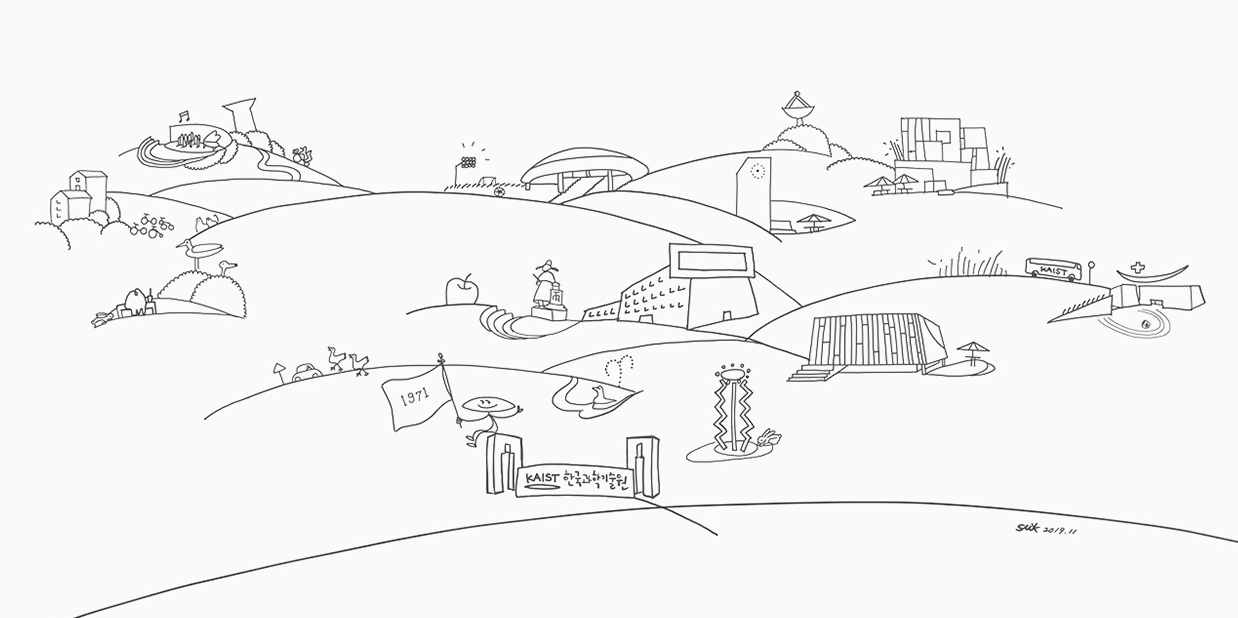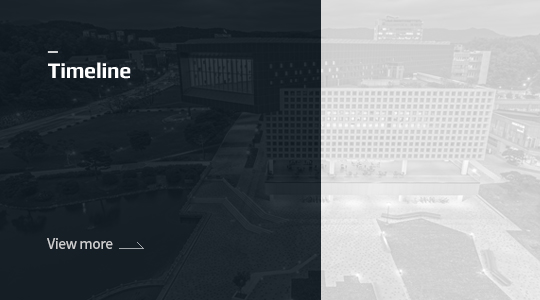KAIST is the first and top science and technology university in Korea. KAIST has been the gateway to advanced science and technology, innovation, and entrepreneurship, and our graduates have been key players behind Korea’ innovations. KAIST will continue to pursue advances in science and technology as well as the economic development of Korea and beyond.

Mission and Vision
KAIST educates, researches, and takes the lead in innovations to serve the happiness and prosperity of humanity. KAIST fosters talents who exhibit creativity, embrace challenges, and possess caring minds in creating knowledge and translating it into transformative innovation.
Vision 2031: Global Value-Creative Leading University
Vision 2031 is KAIST’s strategic development plan that was prepared for the 60th anniversary of KAIST. Vision 2031 reaffirms KAIST’s founding mission as a Korea’s first and top science and technology university to transform into an entrepreneurial university whose knowledge creates global value to benefit all of humanity.
KAIST Safety & Health Management Policy
To fulfill its vision of becoming a “Global Value-Creative Leading University”, KAIST shall create a safe campus and implement the following to build a sustainable campus that contributes to the prosperity and advancement the humanity .
More about KAIST
-
Opened in 1971 Located in Daejeon
-
Comprised of 5 Colleges 7 Schools 13 Graduate Schools 27 Departments
-
Alumni 79,111 BS 21,821 MS 40,465 Ph.D. 16,825
-
Students 11,999 BS 3,980 MS 3,626 Ph.D. 2,855 Joint MS/Ph.D. 1,538
-
Faculty and Staff 1,574 Faculty 666 Staff 908
-
International Population Faculty 137 Students 929
Organization
Leadership

President Kwang Hyung Lee,
KAIST’s 17th President February 2021 ~ Present
Senior Leadership Team
Board of Trustees
University Administration
Founding Philosophy
“All developing countries find the driving force for economic development in science and technology”
(Dr. Chung Kun-Mo, A Report on the Establishment of KAIST )
“By the year 2000, KAIST will be a great institute of technology that will have become the model for a number of similar institutions in other lands.”
(Last chapter “Looking Ahead” of the Terman Report)
History
KAIST marked the 50th anniversary on Feb.18, 2021.
Please visit the official website to see the celebratory events in honor of this milestone.
Emblems/Symbols

- KAIST Seals
- Main Gate
- School Flag
- Nubzuki
- Duck Pond and Geese
- Geese Crossing
- Carillon of Great Scholars
- Newton’s Apple Tree
- Statue of Jang Young-Sil
- Academic Cultural Complex
- Dormitories
- School Song
- Mazinger Tower
- Lyu Keun Chul Sports Complex
- ChungMoonSoul Building
- 13m S/X-Band Transceiver Antenna

KAIST Seals
KAIST stands for the Korea Advanced Institute of Science and Technology. Professor Gyeong-Won Jung at the Department of Industrial Design designed the word mark logo of KAIST in 1993. The emblem evokes the images of expansion, infiniteness, and the universe, which represents the opening to a new world.
KAIST UI
Main Gate
The 10.7m-tall granite structure looks more like a sculpture rather than a gate. There are two rectangular towers symbolizing “science” and “technology” face each other.

School Flag
The first president and physicist Dr. Sang-Soo Lee designate purple as the color of KAIST as it is known to carry the highest quantum energy and it symbolizes progress, creation, and pride.

Nubzuki
A KAIST character describing quirky and funny KAISTians was created in 2014 and is widely beloved by the KAIST community.

Duck Pond and Geese
Flocks of ducks and geese welcome visitors to the duck pond, named after its resemblance to the shape of a duck. The pond became the habitat of ducks and geese from 2000 when Professor Kwang-Hyung Lee brought them to the campus.

Geese Crossing
Families of geese and ducks have the right of way on the KAIST campus. All vehicles must make a full stop when they cross the road. This has become one of the most recognizable events on the KAIST campus.

Carillon of Great Scholars
In honor of the university’s 20th anniversary, KAIST alumni made a gift of the Carillon of Great Scholars. The red, green, and blue pillars symbolize science and technology, which will serve as a beacon of hope for humanity.

Newton’s Apple Tree
Sir Isaac Newton’s apple tree, which inspired him to formulate the law of gravity in Kensington UK, was grafted at the KAIST’s campus in 2006 and bears fruit every year.

Statue of Jang Young-Sil
Jang Young-Sil (1390~?) is a scientist, inventor, and engineer from the 15th century during the Choson Dynasty. He became the highest-ranked scientist and engineer working at the royal court, making many inventions such as a rain gauge, water gauge, sundial, and Korea’s first water clock called Jagyokru. A time capsule commemorating the 30th anniversary of the Daedok Research Complex was buried just beside the statue and will be opened in 2073, the centennial year of when the first freshmen of KAIST were admitted.

Academic Cultural Complex
The main library reopened in 2018 as the Academic Cultural Complex. The main library contains the bulk of KAIST’s collections, which support research, teaching, and learning. The Academic Cultural Complex also provides collaborative working spaces, an idea factory, a multimedia complex, an auditorium, and a sky lounge where various academic and cultural events take place.

Dormitories
A total of 21 on-campus students’ residences accommodate more than 7,600 students.
Dormitories
School Song
Renowned poet Mok-Wol Park and composer Tae-Joon Park made the school song when KAIST was established in 1971. In 1991, the song was re-made after a call for new school song lyrics. The winning entry was refined by poet Han-Ho Do and re-composed by Professor Du-Young Jung at the Korea Baptist Theological University and Seminary.

Mazinger Tower
A water tower facility was built in the 1980s on the top of Eoeun Hill. The tower looked bizarre enough to trigger immense curiosity about the real purpose of the tower. A rumor started that KAIST was secretly manufacturing the robot ‘Mazinger,’ a famous TV cartoon character that was a big hit at that time. Since then, the water tower has been called ‘Mazinger Tower.’

Lyu Keun Chul Sports Complex
The late Dr. Lyu Keun Chul made a gift to build the Sports Complex in the hope of improving the KAIST community’s wellness and health. The 3000-person indoor stadium also serves as the place for hosting various events and ceremonies such as commencement.

ChungMoonSoul Building
The ChungMoonSoul Building houses the Department of Bio and Brain Engineering that promotes the convergence of IT and BT. The building was donated by the former chairman of Mirae Development Co., LTD Chung Moon Soul. He made a gift of 30 billion KRW for this building.

13m S/X-Band Transreceiver Antenna
KAIST SaTRec, which launched the nation’s first satellite KITSAT-1, built the 13-meter-wide antenna for communicating with the satellite in 1997. Four antennas are transreceiving the information of the satellites in orbit around the clock.
Campus Information
Click the links below for directions to our campus, information on campus tours, and a map of the campus.
PR Materials
Sustainability Report
Through the publication of annual ESG reports, our institute will identify our stakeholders’ areas of interest in terms of ESG activities on a yearly basis, and we will disclose the outcomes of our ESG activities through these reports.

